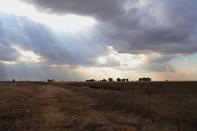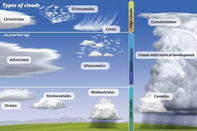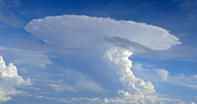Rain is the precipitation of water drops with diameters greater than 0.5 mm. When the drops are smaller, it is usually called drizzle. Rainfall rates are described as light, moderate and heavy rain depending on how much rain will fall in an hour.

For example light rain - 2.5 mm, moderate rain - 2.8 to 7.6 mm and heavy rain - more than 7.6 mm per hour. According to the South African Weather Service, 1 mm of rainfall is equivalent to 1 litre of water in a 1 m x 1 m area with no runoff, infiltration or evaporation.
The Forming of Rain
Rain is produced by clouds. Clouds form when moist air rises. Moist air expands, because of lower pressures higher in the atmosphere, and then cools down. The cooled air becomes saturated with water vapour and this is when condensation occurs.
Condensation is when water droplets are formed on a cold surface or around a particle. As condensation continuous, these water droplets grow until it becomes too heavy for the upward movement of air and fall to the earth.
Clouds

Based on their form, clouds are grouped into two classes: Stratiform clouds are blanket-like and cover large areas. Stratiform clouds form when air layers are forced to rise gradually over large regions, often forming layers.
If the top layer is moist and rising continues, stratiform clouds could bring abundant rain or snow. Cumuliform clouds, which are round or bulb-like in appearance, usually develop upwards. This upward movement causes dense, tall, cumulonimbus clouds that bring thunderstorms.
Classification of Rain

Rain is classified according to its mode of formation.
Convection rain
Convection rain is formed when moist warm air rises from the earth’s surface. Cumulonimbus or cumulus clouds form and rain falls in the form of a localised thunderstorm. A thunderstorm is associated with strong, gusty winds, heavy rain and sometimes hail. In desert areas, water droplets from a thunderstorm may evaporate before reaching the ground. Such rains also occur during summer in sub-tropical areas where there is a combination of moisture in the air and heat.
Orographic rain
Orographic rain forms when moist winds are forced up the side of a mountain. Nimbostratus clouds form and rain falls on the windward side (upwind) of the mountain. Rainfall is low on the leeward side (downwind) of the mountain. This area is classified as being in a ‘rain shadow’. The Little Karoo, around Oudtshoorn, is the most extreme example of a rain shadow in South Africa. Rainfall on the windward, coastal, side of the Outeniqua Mountains can be over 1 000 mm per year, but in most of the Little Karoo, on the leeward side of the mountain, it is less than 200 mm.
Frontal or Cyclonic rain
Frontal or cyclonic rain is caused by low-pressure systems surrounding cyclones. This happens when a warm air mass, warm front, meets a cold front and a cyclone develops, a system with low pressure in the centre and higher pressure around it. The warm air is forced to rise above the colder dense air. The air that rises in the middle cools down, forms nimbostratus clouds and leads to very heavy rain in that area.
Source Water Research Commission